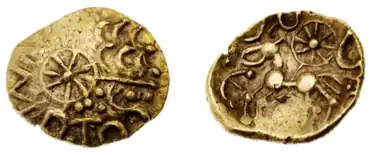Esunertos
Esunertos, or Iisuniirtos (fl. 50-30 BC), was a male ruler in Britain in the western Thames basin in the second half of the 1st century BC. He is known only from a few rare gold and silver coins, which provide an alternate spelling of his name – IISVNIIRTOS.[1]

Etymology
The name Esunertos has no parallel in contemporary histories for Britain, but is a recorded masculine name from the Roman period of occupation in Gaul. The name has been interpreted as 'mighty as Esos', a contemporary Celtic god.[2][lower-alpha 1] It is not clear whether Esunertos was a friend or even usurper of Commius (or Commios). Nevertheless, alongside Commios, his is the earliest attested name on a British-made Iron Age coin.[4]
Dating
Stylistically, the coinage is similar to Commios, ruler of the Atrebates. After Julius Caesar's invasion of Britain in 55 and 54 BC, he was made a client king at Silchester. Commios is known to have struck coins in his own name from 30 BC.[5][6] The three known coins of Esunertos centre around Danebury Hill Fort, placing his territory around this prehistoric site towards the end of the Iron Age period.[4]
Evidence
In March 2023, Lewis Fudge,[7] a metal detectorist unearthed a gold quarter stater coin in a field in the Test Valley of Hampshire.[8][9] It was reported to numismatic experts at the Portable Antiquities Scheme and the Celtic Coin Index at the Ashmolean Museum. The reading was confirmed as [IIS]VNIRTOS, providing a new inscription in the British numismatic record.[10] Prior to the Test Valley discovery, other coins had been incorrectly identified as unsigned issues of the Belgae tribe.[10]
In September 2023, Spink confirmed that a coin of Esunertos would be sold at auction.[4]
On 28 September 2023, Spink announced that this same coin had sold for £20,400 (including Buyer's Premium), setting a record for any Quarter-Stater ever sold at auction.[2]
Footnotes
- The theophoric name is also attested in Continental Europe, interpreted to mean 'having the power of Esus'.[3]
References
- Wills, Sophie. "Coin depicting undiscovered Iron Age ruler set to fetch thousands at auction after being discovered in a field". Yorkshire Evening Post. Retrieved 18 October 2023.
- "A NEW IRON AGE "KING" | Iron Age Britain, Belgae, "Esunertos" (c. 50-30 BC), AV Quarter-Stater". Spink & Son. Retrieved 2023-09-29.
- L. Markey, Thomas; Egetmeyer, Markus; Muller, Jean-Claude (2013). "The boar's tusk of Istres (Bouches-du-Rhône): a Lepontic talismanic inscription". Zeitschrift für celtische Philologie. 60 (1): 129 (entry nr. 13). doi:10.1515/zcph.2013.008.
- "Coin offered at Spink reveals a new mighty Iron Age ruler | Antiques Trade Gazette". www.antiquestradegazette.com. Retrieved 2023-09-18.
- De Jersey, Philip (2001). Celtic coinage in Britain. Shire archaeology. Princes Risborough: Shire Publications. ISBN 978-0-7478-0325-6.
- Bean, Simon C. (1994). The Coinage of the Atrebates and Regni (PhD thesis). University of Nottingham. pp. 238–247.
- Trapnell, Oliver (18 October 2023). "Gold coin could shed new light on British history as previously unrecorded king discovered". GB News. Retrieved 18 October 2023.
- "Name of Unknown Iron Age Ruler Discovered on 2000-Year-old Coin Found in English Field". Good News Network. 2023-09-10. Retrieved 2023-09-12.
- Leffman, Jim (18 October 2023). "A new king has been added to Britain's history books". The Independent. Retrieved 18 October 2023.
- The British Museum (10 February 2015). "Record ID: HAMP-9E612E - IRON AGE coin". The Portable Antiquities Scheme. Retrieved 2023-09-12.